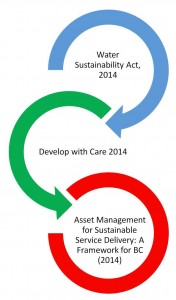BC’s new Water Sustainability Act addresses seven policy areas that bring together 19 of the 45 Living Water Smart commitments
Note to Reader:
 The Province of British Columbia has long recognized that communities are in the best position to develop solutions which meet their own unique needs and local conditions. Furthermore, the emphasis in BC is on progressing towards a desired outcome.
The Province of British Columbia has long recognized that communities are in the best position to develop solutions which meet their own unique needs and local conditions. Furthermore, the emphasis in BC is on progressing towards a desired outcome.
Three landmark initiatives came to fruition in 2014. All embody the enabling philosophy. Together they provide a platform for integrated and coordinated actions that would enable local governments to achieve Sustainable Watershed Systems, through Asset Management.
Accepted ‘standards of practice’- especially those for engineering, planning and finance – influence the form and function of the Built Environment. Creating a watershed health legacy will ultimately depend on implementing ‘Design with Nature’ standards of practice.
TO LEARN MORE:
To download a PDF copy of the article posted below, click on Water Sustainability Act: an overview. This is an extract from Part B of ‘Beyond the Guidebook 2015: Sustainable Watershed Systems, through Asset Management’, released by the Partnership for Water Sustainability in November 2015. This content was contributed by Jennifer Vigano, Water Policy, BC Ministry of Environment. Jennifer helped to write the new Act.
To download a copy of Beyond the Guidebook 2015, click on:
https://waterbucket.ca/viw/files/2015/11/Beyond-Guidebook-2015_final_Nov.pdf.
To visit the homepage for this guidance document, click on:
https://waterbucket.ca/rm/category/british_columbia_guidance_documents_context/beyond-the-guidebook-2015/
Water Sustainability Act
(Bill 18, 2014)
A decade in the making, the new Water Sustainability Act is an historic achievement. The Act is the signature piece in a policy and legislative framework that establishes expectations and direction for adapting to a changing climate. The Act recognizes the connection between land use actions and the implications for the both the water cycle and watershed sustainability.
The Act will have widespread impacts on how water and land practitioners conduct their work.
Seven Policy Areas
The Act addresses seven policy areas. These policy areas bring together 19 of the 45 Living Water Smart commitments that are ultimately implemented through the Act, build on the current merits of the Water Act and bring in new policy tools which will help manage BC’s water more sustainably into the future.
One policy area – consider water in land use decisions – helps to address the potential impacts of land use actions on water. To do this, the Water Sustainability Act enables a number of tools which will help decision makers better manage the impacts of land use on water.
The development of Water Objectives and Water Sustainability Plans are two tools for managing the impacts of land use on water.
Connecting Land and Water
Under the Water Sustainability Act, Water Objectives promoting protection of water quality, water quantity and aquatic ecosystem health will be established in regulation and further defined in policy.
Strategic Water Lens for Making Decisions:
Establishing the Water Objectives will also build on the provincial government’s current initiatives related to cumulative effects management and environmental mitigation. Having Water Objectives will help support decision-making across a number of natural resource statutes, and in particular support a more consistent approach for the consideration of the impacts that land-based activities can have on water.
By establishing broad province-wide objectives and an evaluation framework that can be customized by region, decision makers will have a strategic water lens that can be used in decision making so the decisions they make will better integrate objectives for water quantity, water quality, and aquatic ecosystem health.
Integration with Local Government Planning:
The Water Sustainability Act also allows for the development of Water Sustainability Plans. These collaboratively developed plans can integrate water and land use planning and can be combined with other local, regional or provincial planning processes to address water-related issues focused on addressing or preventing conflict, mitigating risk to water quality, water quantity and aquatic ecosystem health or restoring watershed function.
Process for Water Sustainability Action Plans:
“ The scale and scope of each plan – and the process used to develop it – would be unique, and would reflect the needs and interests of the watersheds affected. Planning will be an effective tool where the need is great, and where other area-based management tools are not able to address the links between land use and watershed impacts,” explains Jennifer Vigano, Water Policy, BC Ministry of Environment. Jennifer helped to write the new Act.
The scale and scope of each plan – and the process used to develop it – would be unique, and would reflect the needs and interests of the watersheds affected. Planning will be an effective tool where the need is great, and where other area-based management tools are not able to address the links between land use and watershed impacts,” explains Jennifer Vigano, Water Policy, BC Ministry of Environment. Jennifer helped to write the new Act.



